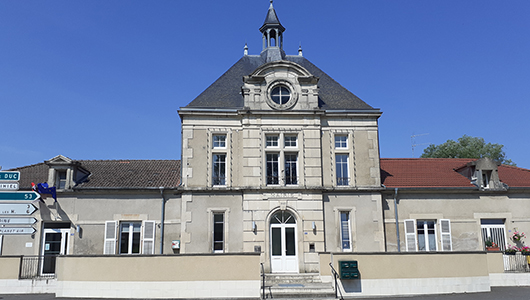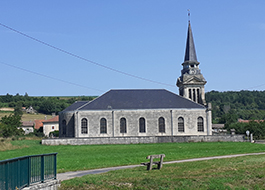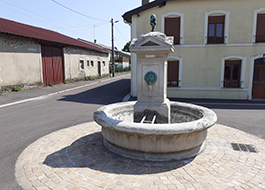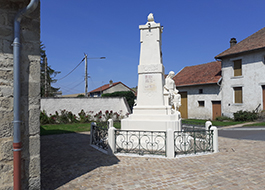Chaillon
Durée visite : 60 minutes
Moyen : Pédestre
Chaillon est occupé dès l’époque gallo-romaine. En 1180, la localité est mentionnée dans une bulle d’Alexandre III relative à l’abbaye de l’Étanche. En 1321, le comte de Bar rachète la seigneurie. Le village est intégré au Barrois non mouvant. Il est rattaché au marquisat, à la prévôté et à l’office d’Hattonchâtel, au bailliage de Saint-Mihiel, au présidial de Toul et à la cour souveraine de Nancy. Le roi de France et le marquis d’Heudicourt en sont les seigneurs, hauts et moyens justiciers. La paroisse relève du diocèse de Verdun, de l’archidiaconé de La Rivière et du doyenné d’Hattonchâtel. Le mille-feuille administratif n’est donc pas récent ! En 1766, le village devient français par le rattachement de la Lorraine à la France. En 1794, le curé Valentin est condamné à la déportation. Il a rétracté son serment à la constitution civile du clergé. Chaillon est occupé par les Allemands de septembre 1914 à septembre 1918. Il est entièrement détruit par les combats et les bombardements. Aussi la commune reçoit en 1921 la croix de guerre avec citation à l’ordre de l’armée.
Chaillon has been occupied since the Gallo-Roman era. The locality is mentioned in 1180 in a bull of Alexander III relating to the Abbey of l’Étanche. In 1321, the Count of Bar bought the seigniory. The village is integrated into the non-moving Barrois. It is attached to the marquisate, the provostship and the office of Hattonchâtel, the bailiwick of Saint-Mihiel, the presidial of Toul and the sovereign court of Nancy. The King of France and the Marquis d’Heudicourt are the lords, high and middle justices. The parish comes under the diocese of Verdun, the archdeaconry of La Rivière and the deanery of Hattonchâtel. The administrative mille-feuille is therefore not recent! In 1766, the village became French by the attachment of Lorraine to France. In 1794, the priest Valentin was sentenced to deportation. He retracted his oath to the civil constitution of the clergy. Chaillon was occupied by the Germans from September 1914 to September 1918. It was completely destroyed by fighting and bombing. Also the town receives in 1921 the war cross with citation to the order of the army.
Chaillon ist seit der gallo-römischen Zeit besetzt. Der Ort wird 1180 in einer Bulle von Alexander III. in Bezug auf die Abtei von l’Étanche erwähnt. 1321 kaufte der Graf von Bar die Herrschaft. Das Dorf ist in das sich nicht bewegende Barrois integriert. Es ist der Markgrafschaft, der Provostschaft und dem Amt von Hattonchâtel, der Vogtei von Saint-Mihiel, dem Präsidialamt von Toul und dem souveränen Gericht von Nancy angegliedert. Der König von Frankreich und der Marquis d’Heudicourt sind die Lords, hohe und mittlere Richter. Die Pfarrei untersteht der Diözese Verdun, dem Archidiakonat La Rivière und dem Dekanat Hattonchâtel. Das administrative Mille-Feuille ist also nicht neu! 1766 wurde das Dorf durch die Angliederung Lothringens an Frankreich französisch. 1794 wurde der Pfarrer Valentin zur Deportation verurteilt. Er widerrief seinen Eid auf die bürgerliche Verfassung des Klerus. Chaillon war von September 1914 bis September 1918 von den Deutschen besetzt. Es wurde durch Kämpfe und Bombenangriffe vollständig zerstört. Auch die Stadt erhält 1921 das Kriegskreuz mit Erwähnung zum Orden des Heeres.

Les habitants et les habitantes de Chaillon s’appellent les Chaillonnais et les Chaillonnaises.
The inhabitants of Chaillon are called Chaillonnais and Chaillonnaises.
Die Einwohner von Chaillon werden Chaillonnais und Chaillonnaises genannt.
Les points de visites
.
Datant de 1841, cette église remplace un précédent édifice, qui était situé à l’entrée du village. En 1851, le cimetière est également déplacé. Les ossements qu’il contenait sont déposés dans un monument. Le clocher est reconstruit après son effondrement en 1907, puis l’édifice est dévasté au cours de la Première Guerre mondiale. Il en subsiste les murs de la nef, la base des piliers et trois niveaux du clocher, qui sont conservés lors de la restauration et reconstruction de 1929.
Dating from 1841, this church replaces a previous building, which was located at the entrance of the town. In 1851, the cemetery was also moved. The bones it contained are deposited there in a monument. The bell tower was rebuilt after its collapse in 1907, then the building was devastated during the First World War. There remain the walls of the nave, the base of the pillars and three levels of the bell tower, which were preserved during the restoration and reconstruction of 1929.
Diese Kirche aus dem Jahr 1841 ersetzt einen Vorgängerbau, der sich am Eingang der Kirche befand Stadt, Dorf. 1851 wurde auch der Friedhof verlegt. Die darin enthaltenen Knochen sind dort in einem Denkmal deponiert. Der Glockenturm wurde nach seinem Einsturz 1907 wieder aufgebaut, dann wurde das Gebäude im Ersten Weltkrieg verwüstet. Es bleiben die Wände des Kirchenschiffs, der Sockel der Säulen und drei Ebenen des Glockenturms, die bei der Restaurierung und dem Wiederaufbau von 1929 erhalten blieben.
.
.
Cette fontaine, constituée d’une grande vasque, permet, au XIXe siècle, d’abreuver les troupeaux à la sortie de la ferme, avant le départ pour le pré. Un support métallique repose sur le rebord. Il facilite le remplissage des récipients en eau potable, destinée à la consommation ou à la cuisson des aliments.
This fountain, made up of a large basin, was used in the 19th century to water the herds at the exit of the farm, before leaving for the meadow. A metal bracket rests on the rim. It makes it easier to fill containers with drinking water, intended for drinking or cooking food.
Dieser Brunnen, der aus einem großen Becken besteht, wurde im 19. Jahrhundert verwendet, um die Herden am Ausgang des Hofes zu tränken, bevor sie auf die Weide gingen. Auf der Felge ruht ein Metallbügel. Es erleichtert das Befüllen von Behältern mit Trinkwasser, die zum Trinken oder Kochen von Speisen bestimmt sind.
.
Le monument aux morts est dû au sculpteur Dante Donzelli. Il est inauguré en présence du président Raymond Poincaré, le 16 août 1930. Il porte les noms des soldats de Chaillon morts au champ d’honneur. Les victimes de 39-45 y ont été ajoutées. La déportation des habitants en Autriche a causé de nombreux décès. Mais le bilan aurait pu être pire. En effet, les Allemands, en garnison à Vigneulles, soupçonnent le village d’abriter des résistants. Le 14 avril 1944, sous le prétexte de la désertion de soldats autrichiens, ils le cernent entièrement, arrêtent tous les hommes et fouillent les maisons. Douze hommes, regroupés devant ce monument, sont sur le point d’être fusillés. Heureusement, les recherches n’aboutissent pas. Un officier donne l’ordre de libérer les villageois.
The monument to the dead is due to the sculptor Dante Donzelli. It was inaugurated in the presence of President Raymond Poincaré on August 16, 1930. It bears the names of the soldiers from Chaillon who died in action. The victims of 39-45 have been added to it. The deportation of the inhabitants to Austria caused many deaths. But the results could have been worse. Indeed, the Germans, garrisoned in Vigneulles, suspected the village of harboring resistance fighters. On April 14, 1944, under the pretext of the desertion of Austrian soldiers, they completely surrounded him, arrested all the men and searched the houses. Twelve men gathered in front of this monument are about to be shot. Fortunately, the searches are unsuccessful. An officer gives the order to release the villagers.
Das Totendenkmal ist dem Bildhauer Dante Donzelli zu verdanken. Es wurde am 16. August 1930 in Anwesenheit von Präsident Raymond Poincaré eingeweiht. Es trägt die Namen der im Kampf gefallenen Soldaten aus Chaillon. Die Opfer von 39-45 wurden hinzugefügt. Die Deportation der Einwohner nach Österreich forderte viele Tote. Aber die Ergebnisse hätten schlechter sein können. Tatsächlich vermuteten die in Vigneulles stationierten Deutschen, dass das Dorf Widerstandskämpfer beherbergte. Am 14. April 1944 umstellten sie ihn unter dem Vorwand der Desertion österreichischer Soldaten vollständig, nahmen alle Männer fest und durchsuchten die Häuser. Zwölf Männer, die sich vor diesem Denkmal versammelt haben, sollen erschossen werden. Die Suche bleibt glücklicherweise erfolglos. Ein Offizier gibt den Befehl, die Dorfbewohner freizulassen.
.
Le bâtiment date de 1889. La mairie conserve son caractère d’origine, malgré la destruction de sa toiture au cours de la Première Guerre mondiale. De part et d’autre du corps principal se trouvaient les salles de classe de l’école.
The building dates from 1889. The town hall retains its original character, despite the destruction of its roof during the First World War. On either side of the main body were the classrooms of the school.
Das Gebäude stammt aus dem Jahr 1889. Das Rathaus hat trotz der Zerstörung seines Daches im Ersten Weltkrieg seinen ursprünglichen Charakter bewahrt. Auf beiden Seiten des Hauptgebäudes befanden sich die Klassenzimmer der Schule.
.
Datant du XIXe siècle, ce complexe comprend un lavoir, une fontaine et un abreuvoir à quatre bassins. Il est alimenté par un captage très ancien, provenant de la Vigne du Seigneur. Des pierres creusées mises bout à bout et recouvertes de pierres plates en constituent le conduit. Le complexe permet l’abreuvage des grands troupeaux. Il ravitaille en eau potable des habitants de la partie sud du village. Doté d’une toiture en petites tuiles plates et construit en grosses pierres de taille, le lavoir se distingue par ses fenêtres en demi-cercle. Il est restauré après 1918.
Dating from the 19th century, this complex includes a wash house, a fountain and a four-basin drinking trough. It is fed by a very old catchment, coming from the Lord’s Vineyard. Dug stones placed end to end and covered with flat stones constitute the conduit. The complex allows the watering of large herds. It supplies drinking water to the inhabitants of the southern part of the village. With a roof of small flat tiles and built of large cut stones, the wash house is distinguished by its semi-circular windows. It was restored after 1918.
Dieser Komplex aus dem 19. Jahrhundert umfasst ein Waschhaus, einen Brunnen und eine Tränke mit vier Becken. Es wird von einem sehr alten Einzugsgebiet gespeist, das aus dem Lord’s Vineyard stammt. Ausgegrabene Steine, die aneinandergereiht und mit flachen Steinen bedeckt sind, bilden die Leitung. Der Komplex ermöglicht das Tränken großer Herden. Sie versorgt die Bewohner des südlichen Dorfteils mit Trinkwasser. Das Waschhaus mit einem Dach aus kleinen Flachziegeln und aus großen geschnittenen Steinen zeichnet sich durch seine halbkreisförmigen Fenster aus. Es wurde nach 1918 restauriert.
.
Les bombardements violents de la Première Guerre mondiale provoquent la destruction du village. La reconstruction offre la possibilité de modifier l’alignement de certains bâtiments. C’est le cas pour cette maison, qui est rebâtie alignée sur le calvaire, qu’elle intègre dans sa maçonnerie. Dans la même bâtisse, le maçon a incrusté une pierre d’entrée de poulailler, typique de la région et d’ordinaire flanquée d’une échelle de bois.
The violent bombardments of the First World War cause the destruction of the village. The reconstruction offers the possibility of modifying the alignment of certain buildings. This is the case for this house, which is rebuilt aligned with the Calvary, which it integrates into its masonry. In the same building, the mason inlaid a chicken coop entrance stone, typical of the region and usually flanked by a wooden ladder.
Die heftigen Bombenangriffe des Ersten Weltkriegs verursachen die Zerstörung des Dorfes. Die Rekonstruktion bietet die Möglichkeit, die Ausrichtung bestimmter Gebäude zu verändern. Dies ist bei diesem Haus der Fall, das in Ausrichtung auf den Kalvarienberg wieder aufgebaut wird, den es in sein Mauerwerk integriert. Im selben Gebäude legte der Maurer einen für die Region typischen Eingangsstein für den Hühnerstall ein, der normalerweise von einer Holzleiter flankiert wird.













